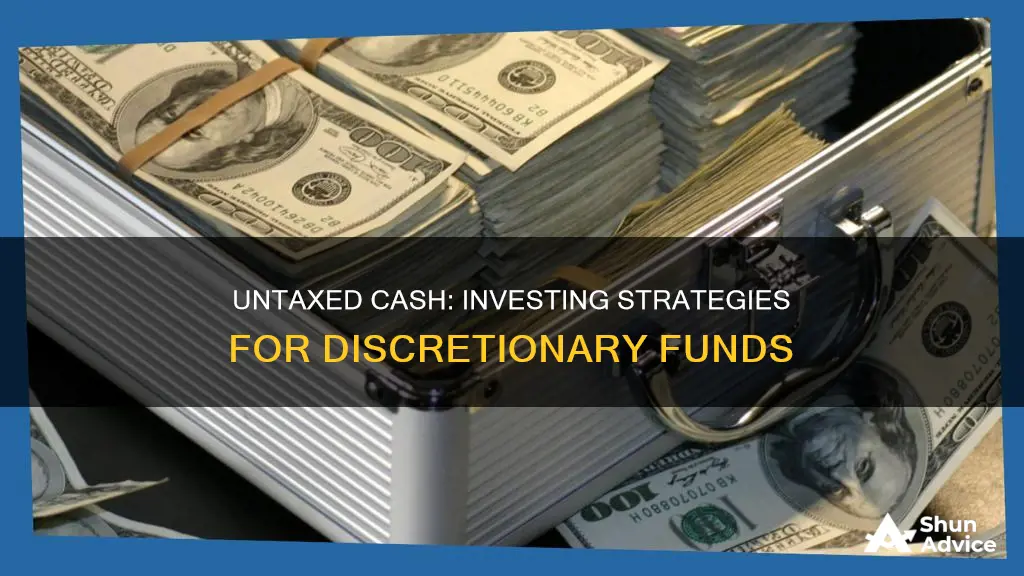
Investing untaxed cash can be a great way to build wealth and reduce your tax liability. There are several options available, each with its own advantages and limitations. Here are some popular ways to invest untaxed cash:
1. Tax-advantaged retirement accounts: Examples include Individual Retirement Accounts (IRAs), 401(k) plans, 403(b) plans, and 457 plans. These accounts allow you to contribute pre-tax income, lowering your taxable income for the year. Your investments grow tax-free, and you pay taxes on the withdrawals during retirement.
2. Health Savings Accounts (HSAs): HSAs are tax-advantaged accounts for individuals with high-deductible health insurance plans. You can contribute pre-tax income, which reduces your taxable income. The money in the account grows tax-free, and qualified withdrawals for medical expenses are also tax-free.
3. Education Savings Accounts: These accounts help you save for education expenses while reducing taxes. Examples include 529 plans and Coverdell Education Savings Accounts. With 529 plans, your contributions grow tax-free, and qualified withdrawals for tuition, textbooks, and other education expenses are tax-free. Coverdell accounts allow tax-free distributions for qualifying education expenses, but any remaining funds become taxable when the beneficiary turns 30.
4. Municipal Bonds: Municipal bonds are issued by local governments to support public improvement projects. The interest earned on these bonds is typically exempt from federal taxes and may also be exempt from state and local taxes, depending on the location.
5. Permanent Life Insurance: Certain types of permanent life insurance policies, such as whole life or universal life, offer tax-free growth and income. The policies have a death benefit and a cash component that can be borrowed against or withdrawn. The cash value grows at a modest rate, and you may not have to pay taxes on the dividends.
| Characteristics | Values |
|---|---|
| Tax-efficient investing | Minimise the tax impact on your investment portfolio |
| Tax-advantaged accounts | IRAs, 401(k)s, 403(b)s, 457s, HSAs, 529s, FSAs, and more |
| Taxable accounts | Brokerage accounts, individual investment accounts |
| Capital gains | An increase in the price of an asset, e.g. stock or property value |
| Capital gains tax | Payable when you sell an investment for profit |
| Dividends or cash income | Money received during the year, taxed for that tax year |
| Tax-loss harvesting | Write off realised investment losses against your gains |
| Asset location | Hold dividend stocks in tax-advantaged accounts |
| 1031 exchange | Sell a property and reinvest gains in a replacement property |
| Long-term capital gains | Held for more than a year, taxed at preferential rates |
| Short-term capital gains | Held for one year or less, taxed at your ordinary income tax rate |
What You'll Learn

Tax-efficient investing strategies
Tax-efficient investing is a strategy that aims to minimise the tax impact on your investment portfolio. It involves selecting investment strategies and accounts that reduce the taxes owed on your returns. By choosing the right mix of taxable and tax-advantaged accounts, you can limit the amount of tax you pay on your investments, leaving you with more money to grow.
Types of investment accounts
There are two main types of investment accounts: taxable and tax-advantaged. Taxable accounts, such as brokerage accounts, offer flexibility with fewer restrictions on contributions and withdrawals. However, the returns in these accounts are subject to taxation, and you'll pay taxes on any capital gains.
On the other hand, tax-advantaged accounts like IRAs and 401(k)s offer tax benefits but have annual contribution limits and more restrictions on withdrawals. These accounts can be further categorised into tax-deferred and tax-exempt accounts.
Tax-deferred accounts
Examples of tax-deferred accounts include traditional IRAs, 401(k)s, and other employer-sponsored retirement plans. You contribute money to these accounts before taxes are deducted, and your investments grow tax-deferred. Taxes are only owed when you withdraw funds in retirement, which can be beneficial if you expect to be in a lower tax bracket at that time.
Tax-exempt accounts
Examples of tax-exempt accounts include Roth IRAs and Roth 401(k)s. Contributions to these accounts are made with after-tax dollars, and your investments grow tax-free. Withdrawals in retirement are also tax-free, but there are restrictions and penalties if you withdraw funds before reaching retirement age.
Maximising tax efficiency
To maximise tax efficiency, it's important to put the right investments in the right accounts. Taxable accounts are generally better suited for investments that lose less of their returns to taxes, while tax-advantaged accounts are preferable for investments that tend to lose more of their returns to taxes.
Additionally, consider diversifying by tax treatment. Holding investments in accounts with different tax treatments can help reduce taxes and provide flexibility in managing your taxes during retirement. This is especially useful if you're uncertain about your future tax bracket.
Tax-efficient investments
Some investments are more tax-efficient than others. Tax-managed funds and exchange-traded funds (ETFs) are tax-efficient as they minimise capital gains distributions, resulting in lower taxes. Municipal bonds are also tax-efficient, as the interest income is typically exempt from federal, state, and local taxes. Treasury bonds and Series I bonds are exempt from state and local income taxes, making them ideal for investors in high-tax states.
Investing Wisely: Understanding Cash Flow & Depreciation
You may want to see also

Tax-advantaged accounts
Types of Tax-Advantaged Accounts
- Tax-Deferred Accounts: Traditional Individual Retirement Accounts (IRAs) and 401(k) plans fall under this category. You contribute money to these accounts before taxes are deducted (pre-tax dollars). Your investments grow tax-deferred, and you only pay taxes when you withdraw funds in retirement. This can be advantageous if you expect to be in a lower tax bracket during retirement.
- Tax-Exempt Accounts: Roth IRAs and Roth 401(k) plans are examples of tax-exempt accounts. Contributions to these accounts are made with after-tax dollars, meaning you don't get an immediate tax break. However, your investments grow tax-free, and you won't owe any taxes on withdrawals during retirement. These accounts typically have restrictions and penalties for early withdrawals.
Benefits of Tax-Advantaged Accounts
- Tax Savings: These accounts allow you to reduce your taxable income now or defer paying taxes on earnings until a later date. This helps you keep more of your money instead of paying taxes on gains or dividends.
- Incentivizing Savings: The tax benefits of these accounts encourage you to save for big goals, such as retirement, education, or healthcare expenses.
- Maximizing Returns: By reducing your tax burden, tax-advantaged accounts enable you to maximize your investment returns.
- Flexibility: Tax-advantaged accounts provide flexibility in terms of contribution limits and withdrawal options, allowing you to choose accounts that align with your specific goals.
Examples of Tax-Advantaged Accounts
- IRAs (Individual Retirement Accounts): Traditional IRAs offer tax-deductible contributions and tax-deferred earnings, while Roth IRAs provide tax-exempt earnings and withdrawals.
- 401(k) Plans: These are employer-sponsored retirement plans that allow you to contribute pre-tax dollars, reducing your taxable income. Both tax-deferred and tax-exempt options are available.
- 529 Educational Plans: These plans allow you to save for college or other qualifying educational expenses with tax-exempt earnings at the state and federal levels.
- Health Savings Accounts (HSAs): HSAs offer both pretax contributions and tax-exempt growth, as long as the funds are used for qualified healthcare expenses.
- ABLE Accounts: Eligible individuals with disabilities can contribute to ABLE accounts, which offer tax-free growth and withdrawals for qualified expenses.
Considerations
While tax-advantaged accounts offer significant benefits, it's important to consider certain factors:
- Contribution Limits: Tax-advantaged accounts typically have annual contribution limits, so it's essential to plan your contributions accordingly.
- Tax Implications: Understand the tax implications of each type of account, as the timing of taxes (pre-tax or post-tax) can impact your overall savings and withdrawals.
- Early Withdrawal Penalties: Some tax-advantaged accounts have restrictions and penalties for early withdrawals, so it's crucial to consider your investment horizon.
- Investment Choices: Different tax-advantaged accounts offer various investment options, so be sure to review the available choices before opening an account.
Understanding Net Cash Flow: Does It Include Investments?
You may want to see also

Tax-free investment options
There are several tax-free investment options available, each with its own unique benefits. Here are some of the top tax-free and tax-deferred investment options:
- 401(k)/403(b) Employer-Sponsored Retirement Plan: These plans offer long-term investment opportunities with pre-tax contributions and potential employer matching, often resulting in lower taxes during retirement. Your pre-tax contributions are deducted from your paycheck, lowering your adjusted gross income (AGI). Many companies offer matching contributions up to a certain amount and may also provide profit-sharing plans. Earnings accrue tax-deferred, and you can generally withdraw them after retirement when you're in a lower tax bracket. There are contribution limits and penalties for early withdrawals. A Roth 401(k) uses after-tax contributions but offers tax-free growth and withdrawals in retirement.
- Traditional IRA/Roth IRA: Individual Retirement Accounts (IRAs) offer tax-free growth. Both Traditional and Roth IRAs allow annual contributions of up to $5,500 (under 50) and $6,500 (over 50). However, income limits and company retirement plans can impact eligibility and deductions. Traditional IRAs allow pre-tax contributions and tax-free withdrawals at a lower tax rate during retirement. Roth IRAs, on the other hand, use after-tax contributions and offer tax-free withdrawals at retirement but have income eligibility requirements. High-income earners may need to employ specific strategies to utilise these options.
- Health Savings Account (HSA): HSAs offer tax-deferred and tax-free earnings on eligible medical expenses. Pre-tax contributions can be tax-deductible, and interest earned is tax-deferred. HSA funds can be used for eligible medical expenses at any time, and withdrawals are typically tax-free. These accounts are limited to high-deductible insurance plan holders.
- Municipal Bonds: Often referred to as "munis," municipal bonds are generally safe investments backed by government entities. They offer potential tax exemptions on federal, state, and city taxes, depending on the bond and your location. Municipal bonds are considered triple tax-free bonds, but not all munis are exempt from taxes, and investing in them may trigger the Alternative Minimum Tax (AMT).
- Tax-Free Exchange-Traded Funds (ETFs): ETFs are low-cost and flexible investment options. They offer tax benefits depending on the types of bonds they hold. For example, US government bond ETFs may be exempt from local and state taxes but are subject to federal tax. Municipal bond ETFs may be exempt from federal, state, and local taxes.
- 529 Education Fund: This plan allows you to save for education expenses with tax-deferred accumulation and potentially tax-free distributions for eligible education costs. While contributions are after-tax and not deductible, distributions for qualified education expenses may be tax-free at the federal level and in some states.
- US Series I Savings Bond: While these bonds are exempt from state and local taxes, you will be liable for federal tax on interest income. However, they can be used to pay for some educational expenses tax-free, depending on income limits and other restrictions.
- Charitable Donations/Gifting: Gifting stocks to charities or dependents can help pass on capital gains tax. Additionally, charitable donations can provide tax deductions when itemising taxes. However, there are restrictions, time limits, and potential downsides to consider.
- 1031 Exchanges: This strategy involves tax-free investing through real estate exchanges, allowing you to defer capital gains tax by reinvesting gains in replacement properties. There are no limits on the number of 1031 exchanges, but there are limitations on which investments can be exchanged, and taxes may be due on differences in amounts between investments.
- Indexed Universal Life Insurance: This is a flexible tax-free retirement strategy that allows you to accumulate a cash value within a life insurance policy. It offers tax-free loans that can be taken throughout the life of the policy and repaid only if desired.
Smart Ways to Invest $10,000 for Maximum Returns
You may want to see also

Tax-free savings accounts
Any Canadian aged 18 or older can open a TFSA and keep the account for as long as they wish. TFSAs have an annual contribution limit, which is the same amount for all Canadians. This limit is indexed to inflation, so it may increase from one year to another. You can put money in at any time, up to the set limits, and take money out at any time without paying any tax.
There are several types of TFSAs, including:
- High-interest TFSA: This type of TFSA acts like a regular high-interest savings account but with tax-exemption benefits. It is ideal for short-term savings or an emergency fund as you can access your funds quickly.
- TFSA term deposits: You can lock away money for a specified period using a tax-free guaranteed investment certificate (GIC) or term deposit. These can be either redeemable or non-redeemable. Non-redeemable options may offer higher interest rates but you won't have immediate access to your money.
- TFSA investment account: This type of TFSA account allows you to invest your TFSA funds. It may be managed by your financial institution or investment firm, or it can be self-directed, meaning you manage it yourself.
Most types of investments can be held in a TFSA, including guaranteed investment certificates (GICs), bonds, stocks, mutual funds, exchange-traded funds (ETFs), and more.
Understanding Cash Equivalents: A Guide to Investing Wisely
You may want to see also

Tax-efficient investments
Tax-efficient investing is a strategy that aims to minimise the tax impact on your investment portfolio. It involves selecting investment strategies and accounts that reduce the taxes owed on your returns. By choosing the right mix of taxable and tax-advantaged accounts, you can limit the amount of tax you pay on your investments, leaving you with more money to grow.
Taxable vs. tax-advantaged accounts
There are two main types of investment accounts: taxable and tax-advantaged. Taxable accounts, such as brokerage accounts and individual investment accounts, offer flexibility with fewer restrictions on contributions and withdrawals. However, the returns in these accounts are subject to taxation. If you sell an investment that has increased in value, you will pay taxes on the gain, known as capital gains tax.
On the other hand, tax-advantaged accounts like Individual Retirement Accounts (IRAs) and 401(k)s offer tax benefits but have annual contribution limits. These accounts allow you to contribute money before taxes are deducted, and your investments grow tax-deferred. You won't owe taxes on the growth until you withdraw funds in retirement, ideally when you're in a lower tax bracket.
Tax-efficient investment strategies
- Buy-and-hold investing: This approach takes advantage of a loophole in IRS tax laws, which states that you're taxed only on realised capital gains when you sell an investment for cash. By holding your investments indefinitely, you can permanently defer any tax on gains. This strategy also tends to outperform active investing over longer periods.
- Traditional IRA or Roth IRA: A traditional IRA allows you to contribute pre-tax money, reducing your taxes now, while a Roth IRA uses after-tax contributions, allowing tax-free growth and withdrawals in retirement.
- 401(k) plan: Similar to IRAs, a traditional 401(k) lets you contribute pre-tax money, while a Roth 401(k) uses after-tax contributions. Both offer the benefit of paycheck deferral and employer matching.
- Tax-loss harvesting: The IRS allows you to offset realised investment losses against your gains, reducing your taxable capital gains.
- Asset location: Consider holding dividend stocks in tax-advantaged accounts to avoid taxes on distributions, and hold stocks with probable capital gains in taxable accounts to take advantage of tax deferral.
- 1031 exchange: If you're a real estate investor, you can sell one investment property and defer capital gains taxes by quickly reinvesting the proceeds into another investment property.
- Long-term capital gains rates: The IRS taxes long-term capital gains at lower rates than short-term gains. By holding your investments for more than a year, you can take advantage of these reduced tax rates.
Strategies for Investing Cash Without IRS Attention
You may want to see also
Frequently asked questions
You can reduce your tax liability by investing in tax-free or tax-efficient options. This includes tax-advantaged accounts like IRAs and 401(k)s, which allow you to save on taxes, as well as tax-managed funds and exchange-traded funds (ETFs).
A 401(k) plan offers tax advantages, such as tax-deductible contributions and tax-deferred growth. It also provides the opportunity for employer-matching contributions, further boosting your savings.
Yes, there are several other options, including Health Savings Accounts (HSAs), 529 Education Savings Plans, and municipal bonds. These options offer tax benefits such as tax-deductible contributions, tax-free growth, or tax exemptions on certain types of income.
When choosing tax-free investments, it's important to consider your financial goals, tax bracket, and eligibility for different options. Consult with a financial advisor or tax professional to determine the most suitable investments for your specific situation.







